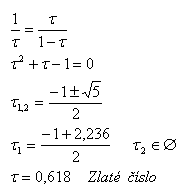Golden ratio
The teacher asked the students to choose the most beautiful rectangle from the given ones with different dimensions. Almost all students chose the same rectangle. How is that possible?
The dimensions of the "most beautiful" rectangle were in the ratio of the "golden section." The golden ratio was already known by the Greek mathematician Euclid (365 – 300 BC) and he defined it as follows: "To divide a line segment by the golden ratio into two parts means to divide it so that the ratio of the larger part to the smaller part is the same as the ratio of the whole segment to the larger part."
Length of the whole segment = 1
Length of the larger part = τ
Length of the smaller part = 1 – τ
 - Golden number
- Golden number
Thus, the most beautiful rectangle had dimensions a = 1 and b = 0.618 (or natural multiples of these numbers). Images that contain the golden ratio appeal to most people. The golden ratio can be found in architecture, painting, and in the proportions of the human body. According to L. da Vinci, the perfect human body is divided at the waist according to the golden ratio. In the works of the genius Austrian composer W. A. Mozart, tone frequencies in a chord were found that are in the ratio 1 : 0.618. Why is the golden ratio so popular? It is related to the activity of the human brain in the process of observation and perception. When observing objects that contain the proportions of the golden ratio, the electrical signals generated in the brain find a favorable response. The brain reacts with a positive feeling of sympathy.